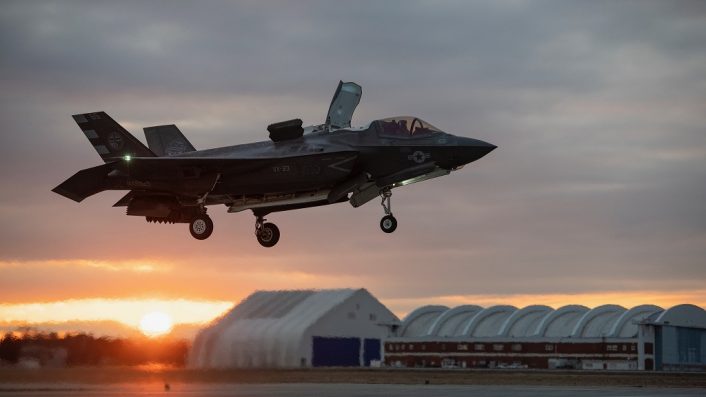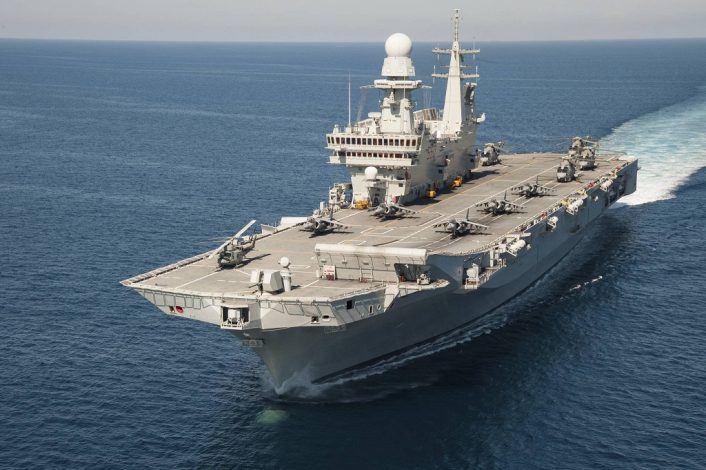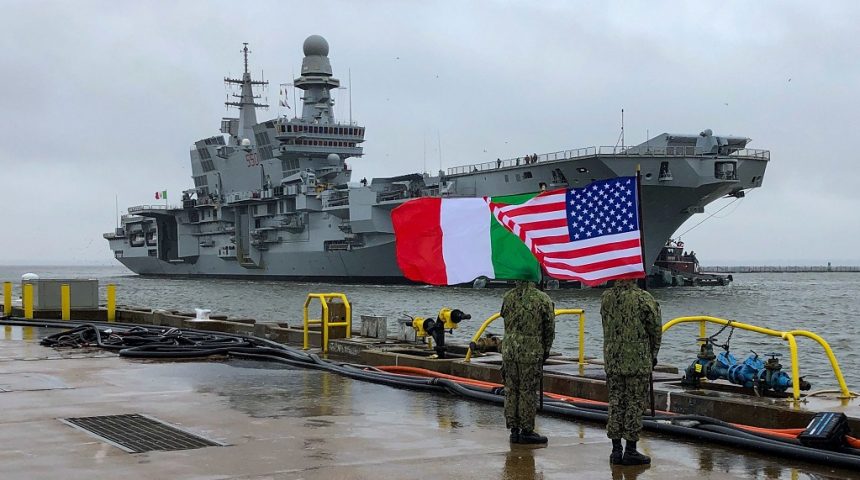The Cavour will test its recent upgrades with the F-35B during six weeks of sea trials, followed by the carrier qualification of the first Italian Naval Aviators with the new aircraft.
The Italian Navy Cavour aircraft carrier (CVH 550), the flagship of the Marina Militare (Italian Navy), arrived at Naval Station Norfolk (Virginia) on Feb. 13, 2021 in preparation for the ship’s F-35B certification campaign with the U.S. Marine Corps. In about two weeks, the ITS Cavour will leave Norfolk to begin the main portion of the “Ready for Operations” deployment, embarking an F-35 Joint Program Office (JPO) test team to conduct sea trials with the new F-35B.
The deployment was announced last month by the Naval Attaché at the Italian Embassy in Washington DC during the Surface Navy Association (SNA) 2021 virtual Symposium. The ITS Cavour left its home port in Taranto on January 28 and made a quick stop in Rota (Spain) before beginning its 10-day crossing of the Atlantic Ocean on its way to the United States, where it arrived after a total of 17 days.
Campagna #ReadyForOperations: #naveCavour è arrivata a Norfolk! Dopo la traversata atlantica il suggestivo ingresso nella baia di Chesapeake e l’ormeggio nel porto della @2ndfleet. Da domani per la portaerei della #MarinaMilitare inizieranno i preparativi per i “Sea trials” pic.twitter.com/Cn0Jh89U62
— Marina Militare (@ItalianNavy) February 13, 2021
Towards the end of the navigation, the Italian ship conducted a three-day interoperability exercise, from February 10 through 12, with the Arleigh-Burke class guided-missile destroyer USS Stout (DDG-55) in the Western Atlantic, with support from Carrier Air Wing (CVW) 7 and Patrol and Reconnaissance Wing (CPRW) 11. Specific events included integrated ship maneuvering, low-slow-flyer detect-to-engage, Anti-Surface Warfare (ASW) training with P-8As Poseidons, air defense/air intercept control event with F/A-18s Super Hornets and C5I (Command, Control, Communications, Computers, Collaboration and Intelligence) interoperability events.
“We are deeply grateful for the warm welcome received by the U.S. Navy 2nd Fleet upon our arrival in the Western Atlantic waters,” said Capt. Giancarlo Ciappina, commanding officer of ITS Cavour. “My officers and the whole crew were impressed for the professionalism and seamanship shown during these three days of training by the crews of USS Stout, CVW 7 and CPRW 11. We consider a real privilege having the opportunity to sail and exercise alongside our closest allies and friends and we are very proud to share with the USN Community such important certification deployment, which will provide ITS Cavour and the Italian Naval Aviation with the 5th generation air combat capability of the Joint Strike Fighter.”
#naveCavour, campagna Ready For Operations: in navigazione verso gli USA, conduce un’interazione addestrativa con #USSStout, un Maritime Patrol Reconnaissance Aircraft e velivoli multiruolo F/A-18 Super Hornet. Cooperazione e interoperabilità della #MarinaMilitare con la @USNavy pic.twitter.com/5OHpXttDt8
— Marina Militare (@ItalianNavy) February 12, 2021
In Norfolk, the ITS Cavour is being hosted by the crew of the USS John. C. Stennis (CVN-74) aircraft carrier, which is coordinating and providing all pier services required by the ship, including refueling, diving operations, equipment and personnel on load, security and contingency medical functions. The Italian aircraft carrier is moored alongside the USS Gerald R. Ford (CVN-78) and the USS Dwight D. Eisenhower (CVN-69).
“We couldn’t be more excited to host our Italian ally,” said Capt. Cassidy Norman, Stennis’ commanding officer. “The Stennis team fully understands the importance of building trust and cooperation by supporting Cavour’s certification with the newest multi-role combat aircraft, the F-35. We are happy to see our Italian naval aviation counterparts dramatically increase their operational capability, strengthening our collective capability.”
Different pier, same willingness to be #GreaterEachDay#MarinaMilitare #NoiSiamolaMarina @USNavy @TheCVN69 @US2ndFleet @NavalNorfolk https://t.co/t1PI8XZVjv pic.twitter.com/2Ir7oIy8RP
— Marina Militare (@ItalianNavy) February 17, 2021
During the upcoming sea trials, the F-35 Patuxent River Integrated Test Force (ITF) will verify the compatibility between the 5th generation fighter aircraft and the ITS Cavour. The trials are an important milestone towards the Initial Operation Capability (IOC) of the F-35B in the Italian Navy, expected by 2024. 200 people, along with two specially instrumented developmental flight test aircraft from Air Test and Evaluation Squadron 23 (VX-23) and their support equipment, will embark on the ship to support the Italian Navy in the F-35B certification process.
“Italy is a critically important Cooperative Program Partner in the F-35 enterprise,” said Andrew Maack, F-35 Pax River ITF chief test engineer and site director. “We are excited to get underway with the sailors of Cavour and honored to contribute to the aircraft carrier achieving the Italian Navy’s strategic goal of it being ‘Ready for Operations’. We look forward to a phenomenally successful shipboard detachment.”
The activities, which should last about six weeks, will take place in an unspecified area of the Western Atlantic and will involve also ships and aircraft from the U.S. 2nd Fleet to improve interoperability and strengthen the relationship between the two NATO Allies.
“Operating in the Western Atlantic with our NATO allies presents a mutually beneficial opportunity to enhance both of our Navies’ capabilities,” said Vice Adm. Andrew Lewis, Commander of U.S. 2nd Fleet. “Supporting our Italian allies in certification of their aircraft carrier increases our collective experience in safety and combat abilities. We are stronger together.”

The test campaign should be pretty similar to the HMS Queen Elizabeth’s Westlant 18 deployment in 2018 (followed by Westlant 19 a year later with British jets), when the two F-35Bs from the ITF flew on and off the ship in eight weeks of intensive trials, testing the integration of the aircraft aboard the ship, the logistics, simulated combat operations and emergencies. It is not known if the new Shipborne Rolling Vertical Landing (SRVL) will be tested on the ITS Cavour, as happened on the British aircraft carrier.
The rolling technique is intended to allow pilots to recover to the ship with more stores: the combination of thrust from its rotating nozzle, lift-fan and lift generated by the wing as an effect of the (slow) forward movement of the aircraft can save up to 7000lbs greater all up weight (UAW). Without the SRVL technique, the F-35B would be forced to jettison some or all of its external store when returning to the ship.
Following the end of the sea trials, the ITS Cavour will be involved in the carrier qualification of the six Italian Naval Aviators that completed their transition on the F-35B at Marine Corps Air Station (MCAS) Beaufort (South Carolina). After the ship’s return in Italy, the Italian Navy is planning to perform the first flight activities with an Italian F-35B from the Cavour. The aircraft to be used will be the fourth F-35B built in Italy and the third to be delivered to the Navy. As we mentioned in previous articles, the first two aircraft built went to the Navy and are now in Beaufort for pilot training, while the third one was delivered to the Air Force.
Now, let’s talk about the ITS Cavour and the upgrades that were performed to make the aircraft carrier compatible with the F-35B. The ITS Cavour has a 220×34 m (about 722×111 ft) flight deck with a 12 degrees ski-jump, enough for 6 landing spots and 8 parking spots. Under the flight deck, a 134×21 m (about 440×69 ft) hangar offers space for 12 helicopters or 8 AV-8B+. The aircraft carrier typically hosts a flight wing of about 20 aircraft, usually a mix of AV-8B+ Harriers and MH/SH-101, MH/SH-90 and SH-212 helicopters. For the “Ready for Operations” deployment, the ship left Italy with only four helicopters onboard, one each of MH-101, SH-101, MH-90 and SH-90.
At the end of 2018, the ITS Cavour begun preparations for the upgrade works, worth € 74 million, which added 300 tonnes to its 27,000 tonnes displacement. During the works, the ship underwent also planned maintenance in anticipation for a future mid-life update of the aircraft carrier, including a 320 tonnes increase of the aviation fuel capacity.
The most important upgrade is, as happened on the US ships, the adaptation for the thermodynamic and acoustic impact of the F-35B on the flight deck, which required strengthening works on the landing spots 2, 3, 4 and 5 to withstand the huge thermal stress caused by the F135 engine. In addition to that, the flight deck areas that will be used by the F-35Bs have been coated with a thermal metal spray that is able to withstand up to 1,500 °C (2732 °F). A second spot for night flight activities has also been added.

In order to support the F-35B precision landing capabilities, the ITS Cavour received the new Raytheon JPALS (Joint Precision Approach and Landing System), which allows safe operations in near-zero visibility conditions with sub-meter accuracy, as well as the most recent version of the SPN-41 precision approach radar. The Italian ship is the first to receive JPALS outside the USA, with the US NAVAIR remotely supporting the local companies that performed installation and integration, as the COVID pandemic prevented US workers to be on the ship during the activities.
Due to the thermo-dynamic stress that required the upgrade of the flight deck, various equipment in the vicinity of the flight deck had to be repositioned or shielded by using thermal deflectors. The ventilation and conditioning system also required modifications to prevent the aspiration of exhaust gases, while the rooms below the flight deck received acoustic shielding.
The ship received also two F-35-specific support systems used by all operators, the ALIS (Autonomic Logistics Information System) and SAPF (Special Access Program Facility), the former being used for maintenance and logistics, while the latter used for mission planning, briefing and debriefing. Changes were required also for the rooms dedicated to the F-35B’s weapons preparation, propulsion and avionics.
The upgraded flight deck, rooms and systems will be tested alongside the F-35B during the sea trials, marking the successful end of the upgrade works and the required readiness to operate autonomously with the F-35B.
#AccaddeOggi, #1febbraio 1991, veniva costituito il Gruppo Aerei Imbarcati della #MarinaMilitare.
30 anni fa la connotazione #ExpeditionarybyNature si arricchiva della componente aerotattica imbarcata#NoiSiamolaMarina pic.twitter.com/MegXBZcGl2
— Marina Militare (@ItalianNavy) February 1, 2021
The Ready for Operation deployment comes also during an important time for the Italian Navy. As a matter of fact, 2021 marks the 160th anniversary of the Marina Militare, the 10th anniversary of the ITS Cavour becoming the fleet’s flagship and the 30th anniversary of the Gruppo Aerei Imbarcati “Wolves” and their operations with the AV-8B+ Harrier.
The Italian Government is currently procuring 90 F-35s, 60 of those are F-35As and the remaining 30 ones are F-35Bs. Out of those 30 F-35Bs, 15 will go to the Navy and 15 to the Air Force. The Navy’s F-35Bs should also operate from the new LHD Trieste.









